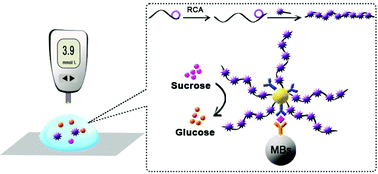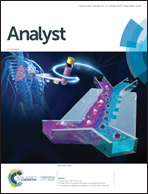Ultrasensitive detection of prostate specific antigen using a personal glucose meter based on DNA-mediated immunoreaction†
Abstract
With the increase in cancer risk, early immunodiagnosis is of great significance for timely therapy. In this work, a DNA-mediated immunosensor for the highly sensitive detection of prostate specific antigen (PSA) is proposed, which is mainly based on a portable personal glucose meter (PGM). Gold nanoparticles (AuNPs) functionalized with PSA detection antibodies and DNA primers are introduced. When the target of the PSA is present, rolling circle amplification (RCA) reactions on AuNPs are triggered and numerous repeated RCA products hybridize with the DNA-conjugated invertase; thus the signal of the PGM is generated and the PSA is quantified indirectly. With the use of a portable PGM, our method realizes a linear detection range of 0.003–50 ng mL−1, with a low detection limit of 0.1 pg mL−1, which is comparable to that of the traditional methods using expensive apparatus. Besides, the analysis of clinical human serum samples is performed to investigate its good practicability. This simple, low-cost, and miniaturized immunosensor is promising for the point-of-care testing of cancer markers.



 Please wait while we load your content...
Please wait while we load your content...